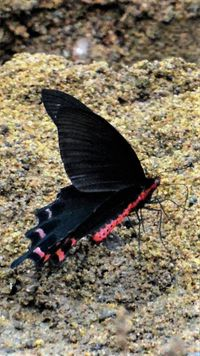This week's butterfly is another one of the Swallowtails whose long thin wings can be spread out in a way that suggests a four-bladed windmill. Originally classified in the genus Papilio, these black-winged Swallowtails were later moved to the genus Atrophaneura, and more recently the Windmill group were given their own genus name, Byasa.
Byasa laos is one of the more recently identified species in this genus, because more seldom seen. You can tell it's a relatively late addition to the list because it's prosaically named after the place where it was found instead of being identified with a character in literature. It took so long to be identified as a distinctive species because it's not common. Google finds more lists that include this species than actual articles about it. Not much is known about it--not even how rare it may be, or whether it's endangered. It is thought to be "near threatened" just because it's rare. In the right time and place, some authors observe, it can be fairly common; a Mr. Nishimura counted 68 males and 17 females visiting one tree on one morning. But its native habitat is a rather small rural area in Laos and might be made unlivable for these butterflies by the proposed development of new towns. The impact on the butterflies of a wildflower in the genus Bidens, an invasive nuisance the butterflies apparently like and pollinate, remains to be seen.
In a paper on "The Papilionidae of Laos," Adam Miles Cotton and Tommaso Racheli describe their work in Laos near these butterflies' habitat. While attention was attracted to the area when someone found a rare species of rodent living there, the authors were impressed by the area's scenic beauty and suggest that, rather than being built up in towns, it could be "developed" for wildlife tourism. They observe that three distinct generations of Byasa laos show distinct, weather-related behavior each year; the August generation are attracted both to roadside Bidens and to dew on paved roads, and are at risk from motor traffic.
Wingspans are about three inches, females slightly larger than males. Males are more likely to have black wings with four pink or red spots on each hindwing. Females can look brown or sepia. The inside edge of the hind wings is pale yellow or white. The body is black above, red below. The Funet.fi index site quotes a 1921 article in a scientific journal saying that the species was "known" to the authors only from a single museum specimen. The scientists agreed that it was different from Papilio alcinous or P. plutonius, though confusible.
Too many web pages for Byasa laos merely prove that people are still buying and selling dead bodies. While butterflies' lives are short and anyone who observes butterflies regularly will find bodies, the position of this web site is that we should never pay for dead bodies. A species as rare as this one seems to be could be wiped out by cash-strapped students in a year.


No comments:
Post a Comment